
Haleakalā, or the East Maui Volcano, is a massive, active shield volcano that forms more than 75% of the Hawaiian Island of Maui. The western 25% of the island is formed by another volcano, Mauna Kahalawai, also referred to as the West Maui Mountains.

The ʻiʻiwi or scarlet honeycreeper is a species of Hawaiian honeycreeper. The ʻiʻiwi is a highly recognizable symbol of Hawaiʻi.

Haleakalā National Park is a national park of the United States located on the island of Maui, Hawaii. Named after Haleakalā, a dormant volcano within its boundaries, the park covers an area of 33,265 acres, of which 24,719 acres is a wilderness area. The land was designated a national park in 1976 and its boundaries expanded in 2005.

Argyroxiphium is a small genus of plants in the family Asteraceae. Its members are known by the common names silversword or greensword due to their long, narrow leaves and the silvery hairs on some species. The silverswords belong to a larger radiation of over 50 species, including the physically different genera Dubautia and Wilkesia. This grouping is often referred to as the silversword alliance. Botanist P. H. Raven referred to this radiation as "the best example of adaptive radiation in plants".

The Polipoli Spring State Recreation Area is a state park of Hawaiʻi in the United States. It is on the island of Maui about ten miles from Kula up the slope of Haleakalā.

Sophora chrysophylla, known as māmane in Hawaiian, is a species of flowering plant in the pea and bean family, Fabaceae, that is endemic to Hawaii. It is highly polymorphic, growing as a shrub or tree, and able to reach a height of 15 m (49 ft) in tree form. Yellow flowers are produced in winter and spring.

Ralph Sheldon Hosmer was Hawaii's first territorial forester, a contemporary of Gifford Pinchot who was among the group of educated American foresters that organized what is now the United States Forest Service. Hosmer later joined the faculty of Cornell University as head of the department of Forestry, where he served for 28 years until his retirement.

The ʻākohekohe, or crested honeycreeper, is a species of Hawaiian honeycreeper. It is endemic to the island of Maui in Hawaiʻi. The ʻākohekohe is susceptible to mosquito‐transmitted avian malaria and only breeds in high‐elevation wet forests.

The Maui ʻalauahio, also known as the Maui Nui ʻalauahio or Maui creeper, is a species of Hawaiian honeycreeper. It is endemic to Maui Nui, Hawaii. The name Maui ʻalauahio is somewhat misleading because the species seems to have occurred on most, if not all, parts of the ancient Maui Nui, which includes the present day islands of Maui, Molokaʻi, Lānaʻi, and Kahoʻolawe. There are two subspecies: the Lānaʻi ʻalauahio, P. montana montana, which occurred on Lānaʻi (extinct); and P. montana newtoni which occurs on Maui. The common name refers to both groups.

The kiwikiu or Maui parrotbill is a species of Hawaiian honeycreeper endemic to the island of Maui in Hawaii. It can only be found in 50 square kilometres (19 sq mi) of mesic and wet forests at 1,200–2,150 metres (3,940–7,050 ft) on the windward slopes of Haleakalā. This species is critically endangered, with an estimated population in 2016 of 250-540 individuals, but more recent estimates of less than 150 individuals. Fossil evidence indicates that the bird could at one time be seen in dry forests at elevations as low as 200–300 metres (660–980 ft), as well as on the island of Molokaʻi.
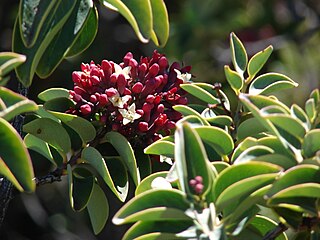
Santalum haleakalae, known as Haleakala sandalwood or ʻIliahi in Hawaiian, is a species of flowering tree in the sandalwood family, that is endemic to the islands of Maui, Lanai, and Molokai in the Hawaiian Islands, part of the United States. It grows in subalpine shrublands at elevations of 1,900 to 2,700 m, especially on the slopes of Haleakalā.
The highland finch is an extinct member of the Fringillidae and a Hawaiian honeycreeper which is known only from a few bones found in caves. It is the only member of the genus Orthiospiza. It was endemic to the high-elevation areas of Mount Haleakalā on the Hawaiian island of Maui. It has been speculated that they were pushed to extinction because of habitat loss. It is known only from fossil remains and likely became extinct before the first Europeans arrived in 1778.
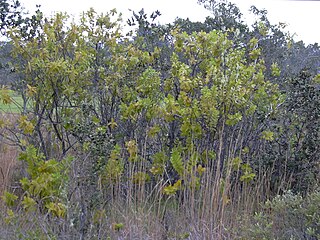
Hawaiian tropical dry forests are a tropical dry broadleaf forest ecoregion in the Hawaiian Islands. They cover an area of 6,600 km2 (2,500 sq mi) on the leeward side of the main islands and the summits of Niʻihau and Kahoʻolawe. These forests are either seasonal or sclerophyllous. Annual rainfall is less than 127 cm (50 in) and may be as low as 25 cm (9.8 in). The rainy season there lasts from November to March.

Cyanea is a genus of flowering plants in the family Campanulaceae that are endemic to Hawaii. The name Cyanea in Hawaiian is hāhā.
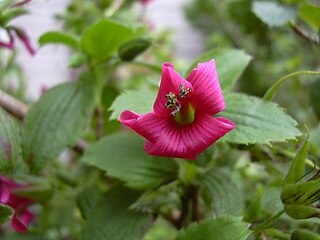
Geranium arboreum is a rare species of geranium known by the common names Hawaiian red-flowered geranium and Hawaii red cranesbill. It is endemic to Hawaii, where it is known only from the island of Maui. It was federally listed as an endangered species in 1992. Like other Hawaiian geraniums, this plant is known as hinahina and nohoanu.

Geranium multiflorum is a rare species of geranium known by the common names manyflower geranium, or manyflowered cranesbill. It is endemic to Hawaii, where it is known only from Haleakalā, the main volcano on the island of Maui. It was federally listed as an endangered species in 1992. Like other Hawaiian geraniums, this plant is known as hinahina and nohoanu.
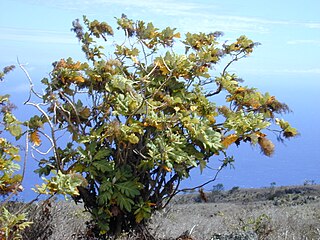
Bocconia frutescens is a species of flowering plant in the poppy family known by many common names, including plume poppy, tree poppy, tree celandine, parrotweed, sea oxeye daisy, and John Crow bush in English, gordolobo, llorasangre, tabaquillo, palo amarillo, palo de toro and pan cimarrón in Spanish, bois codine in French and bwa kodenn in Haitian Kreyòl. It is native to the Americas, including Mexico, parts of Central and South America, and the West Indies. It is perhaps better known in Hawaii, where it is an introduced species and an aggressive invasive weed with rapid negative effects on local ecosystems. In other parts of the United States it is used as an ornamental plant for its "tropical"-looking foliage.

The Aegean and Western Turkey sclerophyllous and mixed forests is an ecoregion in the lands around the Aegean Sea. The ecoregion covers most of mainland Greece, the Greek Aegean Islands, the western coast of Turkey, the southern Vardar river valley in North Macedonia, the southern Struma river valley at the extreme south-western corner of Bulgaria.
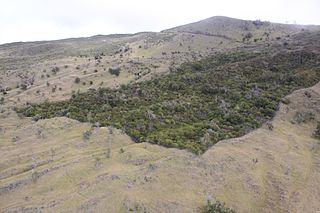
The Auwahi Dryland Forest Restoration Project has produced a substantial forest on the southwestern slopes of Haleakala on the island of Maui. The mostly volunteer-based restoration focuses on the 4,000-foot elevation range.
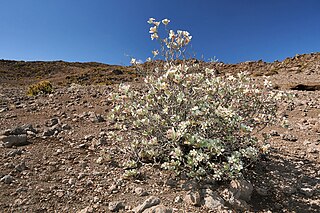
Geranium cuneatum, or silver geranium, is a medium alpine shrub endemic to the islands of Hawai'i and Maui, where it grows in high elevation shrubland near or above the treeline. Like other geraniums native to Hawai'i, it is known as hinahina in Hawaiian.



















